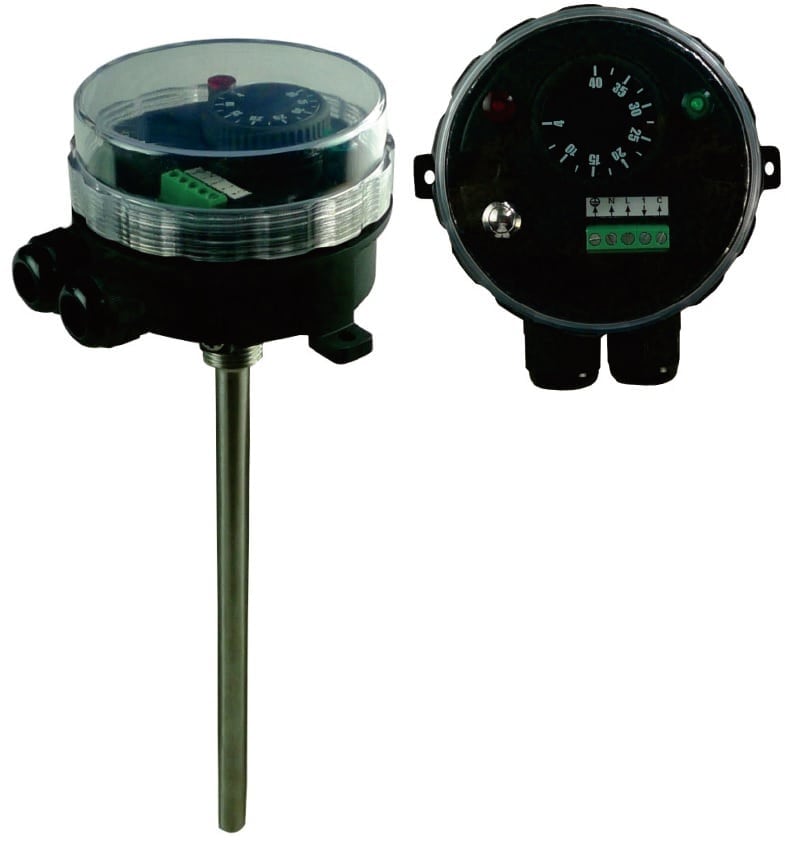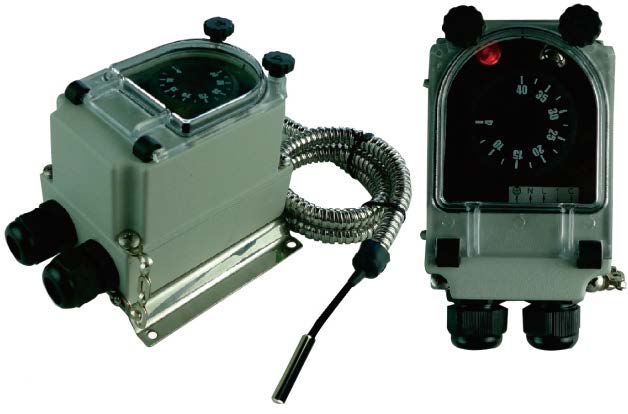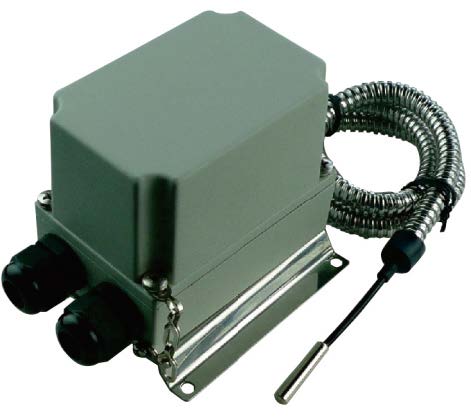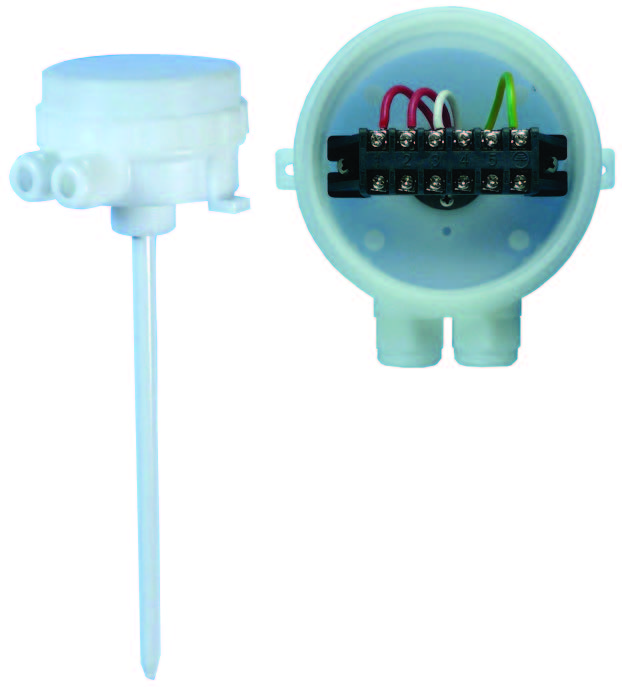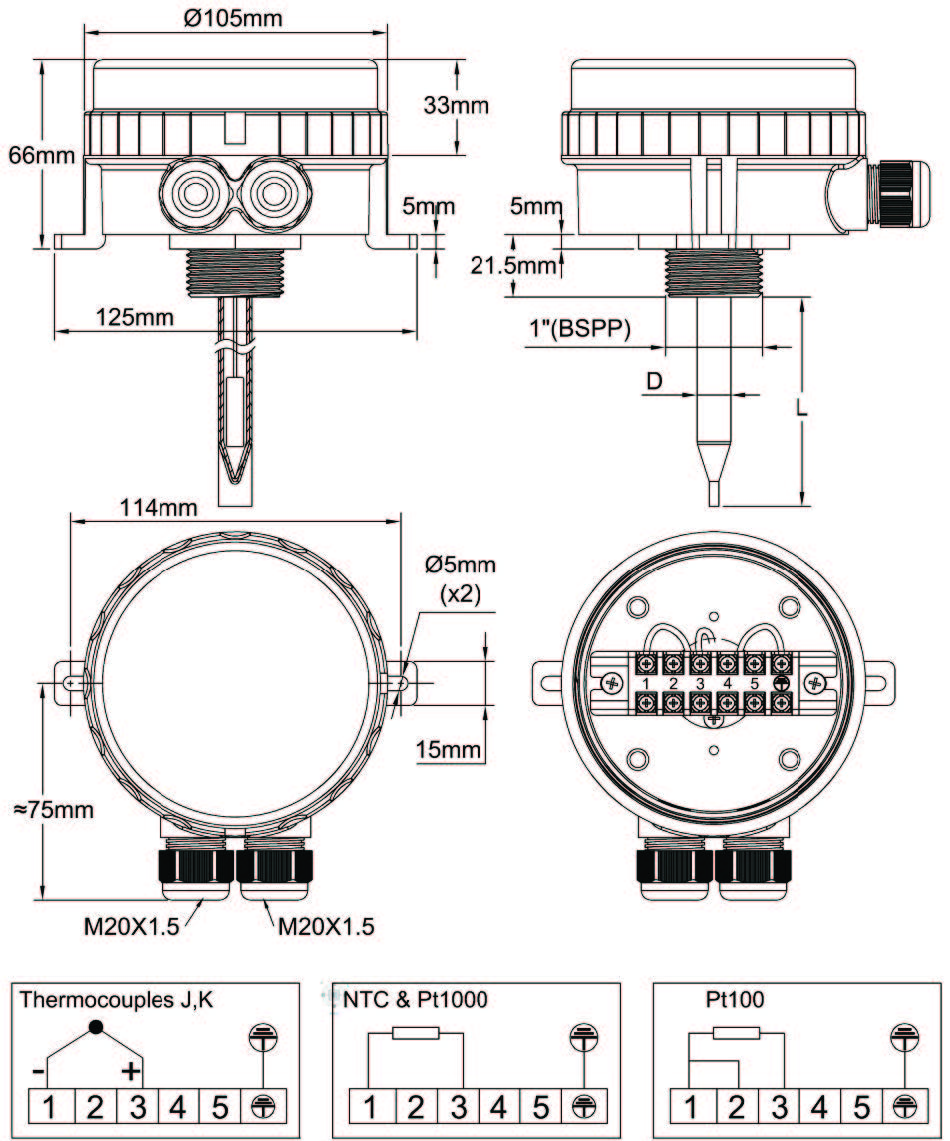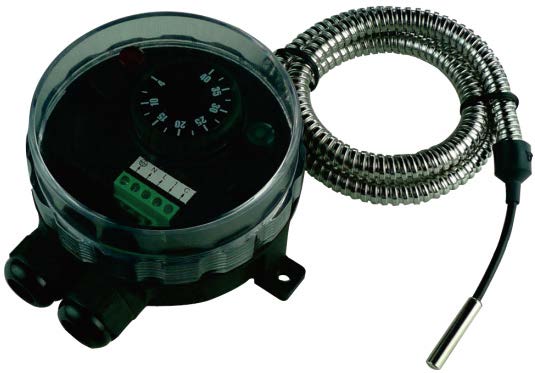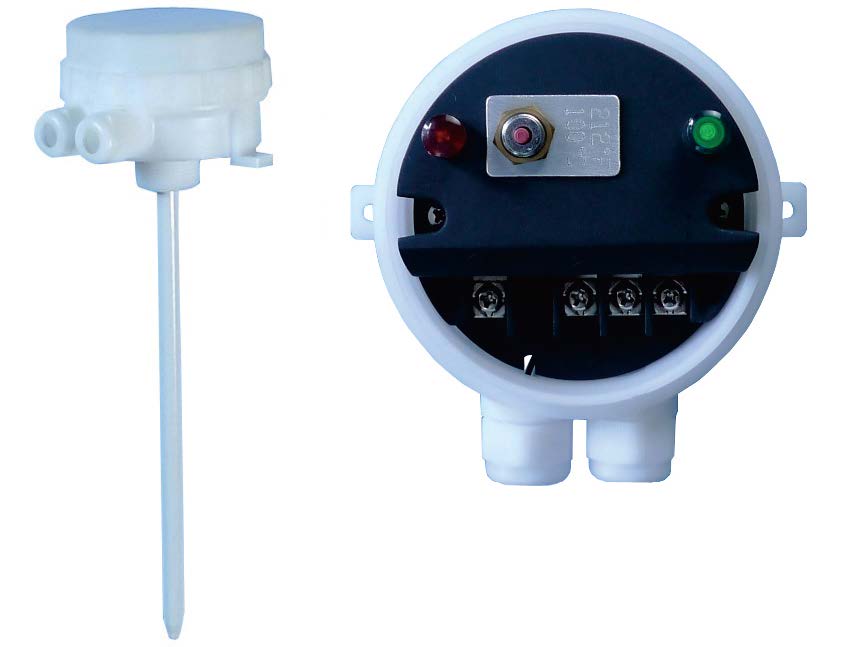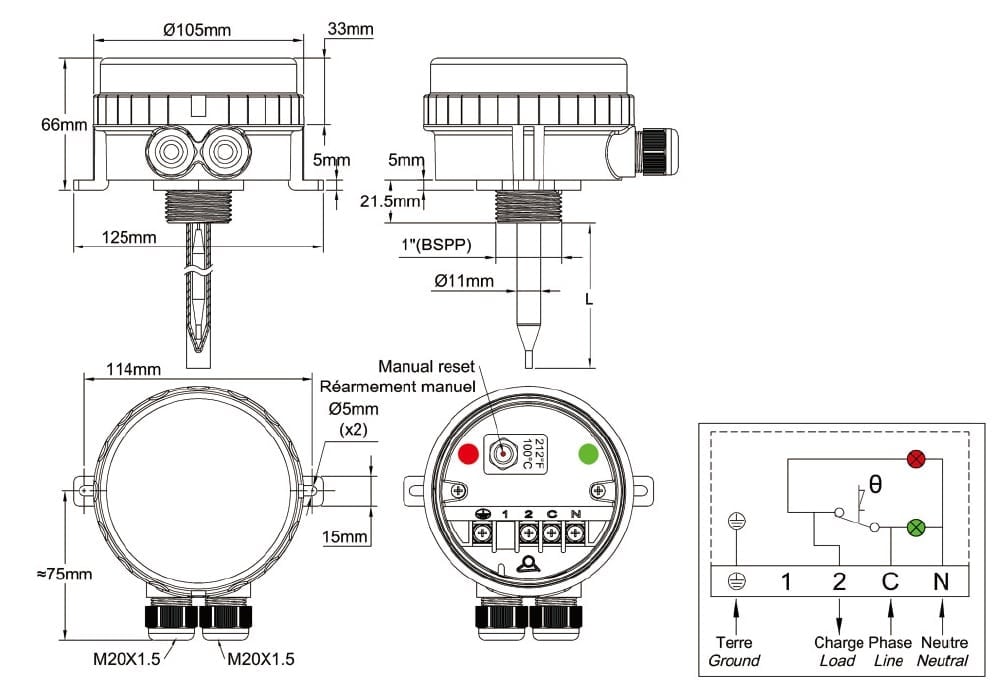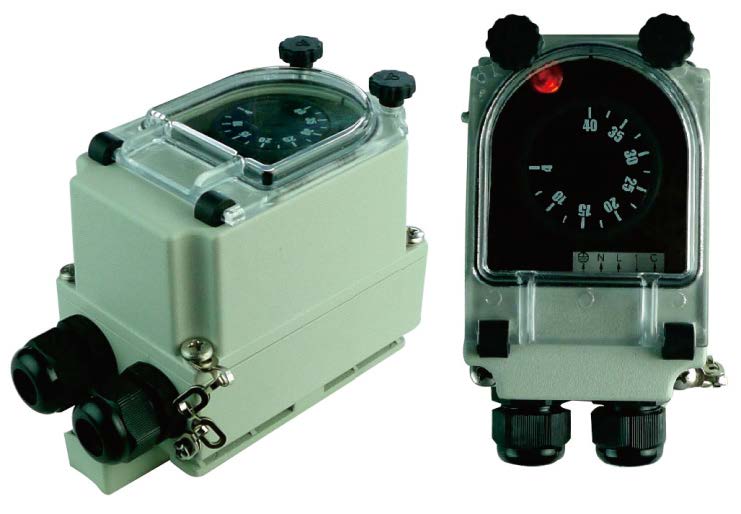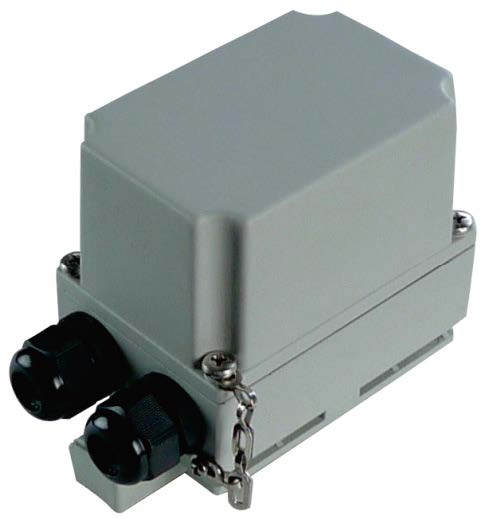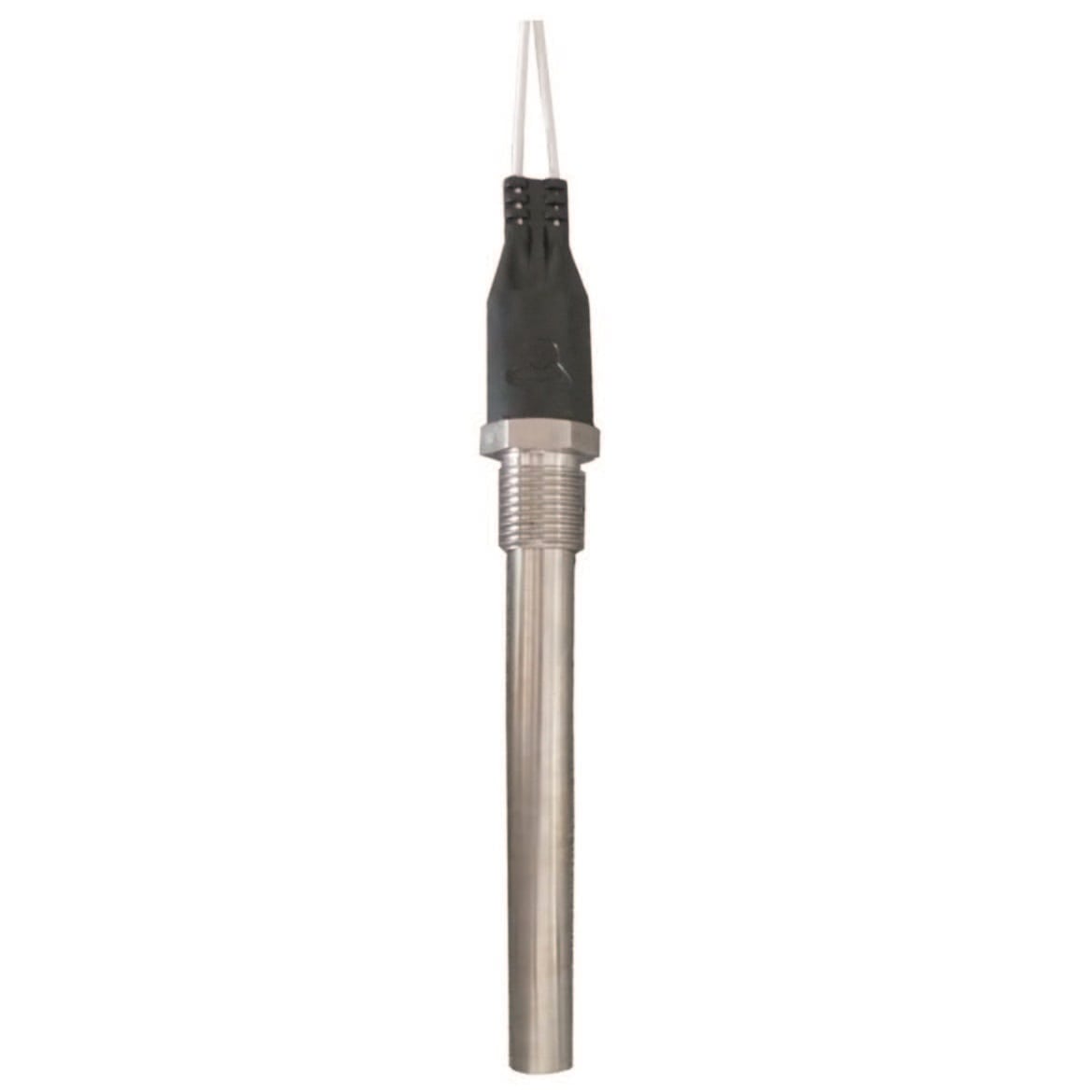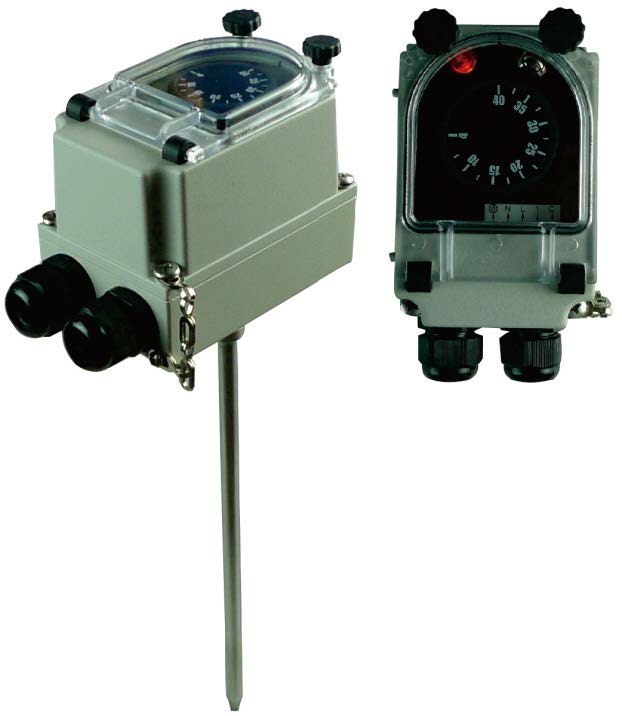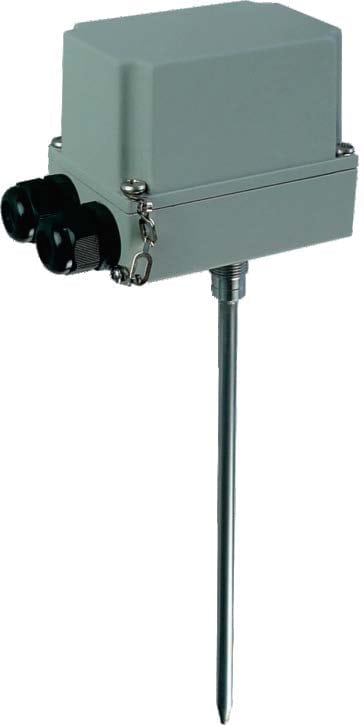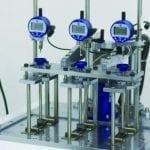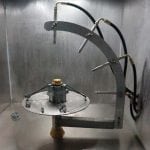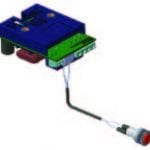Adjustable manual reset electronic rod limiter IP66, IK10
– Equipment requesting a very strong resistance to water ingress. The transparent cover allows to visualize the set point and the 2 pilot lights.
These electronic rod thermostats are installed inside pockets as immersion thermostats in pipelines and containers, and for monitoring temperature in air ducts.
– Manual reset allows the use as high temperature alarm
| Housing raw material | |
|---|---|
| Color | |
| Ingress protection | |
| Mechanical protection | |
| Contact style | |
| Electrical rating | |
| Voltage | |
| Electrical life (cycles at rated value) | |
| Measurement type | |
| Sensing element | |
| Setting adjustment | |
| Rod length (mm) | |
| Rod raw material |
| Enclosure | Type | Operation | Contact | Measurement | Ranges °C | Models |
| IP66, IK10 | Limiter | Electronic | SPNO or SPNC | Probe | 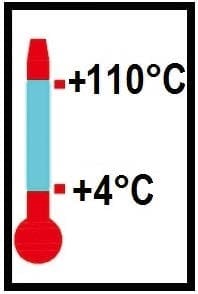 |
YF43NC & YF45NC |
|
Material |
 |
 |
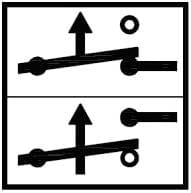 |
 |
||
|
PA66 & PC |
Applications
– Equipment requesting a very strong resistance to water ingress. The transparent cover allows to visualize the set point and the 2 pilot lights.
These electronic rod thermostats are installed inside pockets as immersion thermostats in pipelines and containers, and for monitoring temperature in air ducts.
– Manual reset allows the use as high temperature alarm
Housing: Protection class IP 66 upon EN 60529 (waterproof spray water under high pressure and sea splashes, totally dust tight). Body in black PA66, fiber glass reinforced. The transparent polycarbonate cover can be unscrewed by hand, but it is also possible to use a hook spanner.
Set point adjustment: By °C printed knob. All types have an adjustable rotation limit system located inside the knob that allows reducing the set point adjustment span. °F printed knobs available as an option
Operation:Microprocessor electronic thermostat.
Set point adjustment ranges: -4-40°C (40-105°F); 30-90°C (85-195°F); 30-110°C (85-230°F).
Manual reset button: located beside the knob
Sensing element: Dia. 5mm NTC sensor (10KOhms @25°C), inside nickel plated brass pocket. Thread ½” BSPT. Tube outside diameter 8mm. Maximum temperature on the probe: 120°C (250°F). Located at the bottom of the housing, 2 screws are used to secure standard pockets. (See the compatible brass pockets range in the accessories section).
Pilot lights: One pilot light visualizes the thermostat contact output position. The other visualizes the power supply input. Phase and neutral supply lines are mandatory for these pilot lights.
Cable input and output: Two M20 cable glands, built-in black PA66.
Electrical connections: Inside, on screw terminal connection block. It is possible to connect 2 wires 1.5mm² on each terminal.
Earthing: Internal screw terminal.
Mounting: By the pocket thread or by 2 legs with holes for screws dia. 4 to 5 mm, 114 mm distance.
Identification: Identification label on backside
Contact: SPST. 16A (2.6), 250VAC. Open or close on temperature rise.
Model with contact closing on temperature rise is used to switch on an alarm. Version with contact opening on temperature rise is used to switch off heating.
Electrical life: >100.000 cycles.
Minimum storage temperature: -35°C (-30°F)
Maximum ambient temperature: 60°C (140°F)
For more technical information see 2PE2N6 thermostat technical data sheet
Main references
| Temperature adjustment ranges
°C (°F) |
References with SPNC contact, open on temperature rise | References with SPNO contact, close on temperature rise | Pocket length (L, mm) | Temperature sensing length (mm) |
| 4-40°C (40-105°F) | YF43NC04040118UJ | YF45NC04040118UJ | 110 | 50 |
| 4-40°C (40-105°F) | YF43NC04040178UJ | YF45NC04040178UJ | 170 | 50 |
| 4-40°C (40-105°F) | YF43NC04040238UJ | YF45NC04040238UJ | 230 | 50 |
| 4-40°C (40-105°F) | YF43NC04040308UJ | YF45NC04040308UJ | 300 | 50 |
| 4-40°C (40-105°F) | YF43NC04040458UJ | YF45NC04040458UJ | 450 | 50 |
| 4-40°C (40-105°F) | YF43NC04040608UJ | YF45NC04040608UJ | 600 | 50 |
| 30-90°C (85-195°F) | YF43NC30090118UJ | YF45NC30090118UJ | 110 | 50 |
| 30-90°C (85-195°F) | YF43NC30090178UJ | YF45NC30090178UJ | 170 | 50 |
| 30-90°C (85-195°F) | YF43NC30090238UJ | YF45NC30090238UJ | 230 | 50 |
| 30-90°C (85-195°F) | YF43NC30090308UJ | YF45NC30090308UJ | 300 | 50 |
| 30-90°C (85-195°F) | YF43NC30090458UJ | YF45NC30090458UJ | 450 | 50 |
| 30-90°C (85-195°F) | YF43NC30090608UJ | YF45NC30090608UJ | 600 | 50 |
| 30-110°C (85-230°F) | YF43NC30110118UJ | YF45NC30110118UJ | 110 | 50 |
| 30-110°C (85-230°F) | YF43NC30110178UJ | YF45NC30110178UJ | 170 | 50 |
| 30-110°C (85-230°F) | YF43NC30110238UJ | YF45NC30110238UJ | 230 | 50 |
| 30-110°C (85-230°F) | YF43NC30110308UJ | YF45NC30110308UJ | 300 | 50 |
| 30-110°C (85-230°F) | YF43NC30110458UJ | YF45NC30110458UJ | 450 | 50 |
| 30-110°C (85-230°F) | YF43NC30110608UJ | YF45NC30110608UJ | 600 | 50 |
Downloadable
Related products
Electronic control thermostats
Remote temperature limiter boxes
Manual reset electronic adjustable limiter, remote sensor, IP65
Rod temperature limiter boxes
Remote temperature control boxes
Rod temperature limiter boxes
Pipe surface temperature control boxes
Pipe mounting electronic temperature control thermostat IP65
Rod temperature limiters
Dia. 10mm cartridge thermostat 1/2″BSPT or M14x1.5 fitting, calibration from 50 to 120°C
Rod temperature limiter boxes
Technical informations associated to this product
-
Main properties of plastic raw materials used for enclosures
The classic housings, with only 5 sides and a lid, require a long and costly layout, most of the time ignoring the application needs: security, fire resistance, water penetration, shocks, UV, temperature, etc. -
Electrical protection classes
The housings are designed to protect electrical equipment located inside. This protection must be considered in the electrical and environmental angles.) -
Thermostats installation
The proper functioning of a thermostat depends primarily on the correct choice of the component, but also the conditions of its installation. Conditions used to calibrate regulating and control equipment in the factory are always ideal laboratory conditions, ensuring measurement accuracy and repeatability. These conditions are rarely those found in practice when installing thermostats. However, with a minimum of constraints, it is possible to optimize assemblies.

